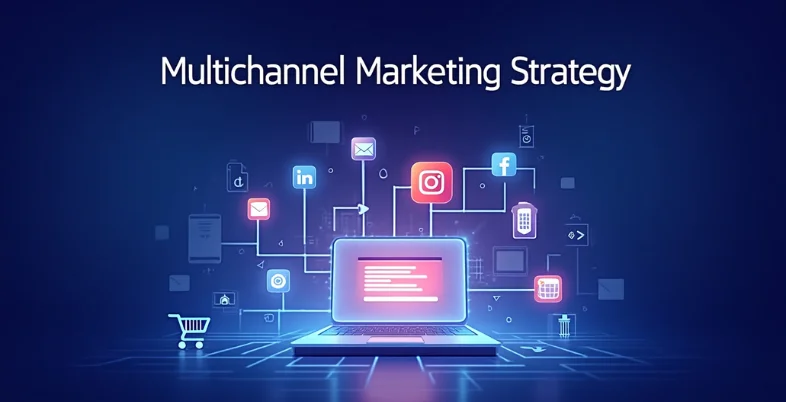You’ve probably noticed: the Internet is loud.
Every scroll, swipe, and stream comes with a sales pitch. Ads sneak in between your Spotify playlists, interrupt YouTube videos, pop up on Instagram, and trail you across websites. Add in TV, podcasts, billboards, and even the side of your Uber, and it’s no wonder people tend to tune out.
If you’re a business trying to get noticed, you’ve got to find a way to cut through that noise.
These days, it takes more than a one-channel approach to make someone stop mid-scroll and think, “Wait, this might be for me.” You need to show up where they already are. And more importantly, where they’re already paying attention.
To do that, you need a smart multichannel marketing strategy that also focuses on establishing a consistent brand identity to create trust and recognition across all touchpoints.
But don’t mistake “multichannel” for “everywhere, all at once.” Dumping your message on every platform without a plan is a quick way to burn your budget and confuse your audience.
Instead, we’ll show you how to build a focused strategy that connects all the dots between channels like email, social, paid ads, and more, so your marketing works together to convert clicks into customers.
Step-by-Step: Build a Multichannel Marketing Strategy That Actually Works
Building a multichannel approach starts with the basics: knowing what you’re trying to achieve, and which paths will actually take you there.
Let’s kick things off with the first step.
Step 1: Set Clear Goals (And Do It Before Choosing the Channels)
Your goals determine your channels, not the other way around.
Maybe your competitors are investing heavily in YouTube, or someone on your team suggests you “should really be on TikTok.” But if you don’t know what you’re trying to achieve, you’re just throwing ideas at the wall.
Begin with your objectives. Are you aiming to increase qualified leads, improve customer retention, or boost conversions? Your goals will shape the rest of your strategy, including where you invest your time and budget. They also guide the tools you choose to support execution.
For instance, if one of your goals is to improve customer engagement, using a customer engagement software like a CRM for SMS campaigns can help you stay connected with targeted, timely messages. If you’re aiming to boost lead conversion, you might explore platforms like Mailchimp or ActiveCampaign to automate email sequences and manage responses more effectively.
When your strategy starts with clear, measurable goals, choosing the right channels becomes a smart decision, not a guess.
Step 2: Know Your Audience (And Where They Spend Their Time)

Just because a platform exists doesn’t mean you need to be on it. It’s easy to fall into the trap of thinking you need to be everywhere at once, but the reality is that the most effective strategies focus on where it matters.
To do that, you need to understand who your audience is and what platforms they use.
Demographics can tell you a lot. According to Pew Research, YouTube remains one of the most widely used platforms across nearly every age group, while TikTok and Snapchat are popular with Gen Z. LinkedIn tends to attract a more professional, older audience. These patterns should guide your choices.
Here’s how you can start gathering that intel:
- Survey your customers and ask where they spend most of their time online (social media, podcasts, news sites, email, etc.).
- Review campaign performance data to see which channels have delivered the strongest ROI or engagement so far.
- Use analytics or CRM tools to see where your leads are coming from.
- Compare platform demographics to your ideal customer profile.
Step 3: Choose the Right Mix of Channels to Reach Your Audience

Once you know what you’re trying to achieve and where your audience hangs out, the next question is: Where are your customers actually spending their time?
To figure this out, pay attention to behavior. What platforms do your customers use daily? Where do they go to discover new products, read reviews, or make purchases?
Here are some channels worth considering for your multichannel marketing mix:
- Your website: This is often the central hub for everything. Every campaign, ad, or post should lead back here. Make sure it’s optimized, fast, and provides a seamless user experience.
- Search Engine Optimization (SEO): Organic search is still a top source of high-intent traffic. Ranking well in search results gives your brand credibility and long-term visibility.
- Pay-Per-Click (PPC) ads: Great for quick wins and highly targeted campaigns, especially when paired with SEO.
- Social media (organic): Platforms like Instagram, LinkedIn, and Facebook help build community, offer customer support, and humanize your brand.
- Social media advertising: Paid social can help you scale awareness and drive traffic quickly with advanced targeting. Using an AI Ad Generator can make it easier to create ad creatives that align with your targeting and boost campaign efficiency
- Email marketing: A reliable channel for nurturing leads and staying top of mind. It’s direct, personal, and cost-effective. o maximize deliverability and ensure your messages reach the inbox, regular domain health check is essential to maintain sender reputation and avoid spam filters.
- SMS marketing: With open rates often above 90%, text messaging is one of the most effective ways to reach people quickly, especially for flash sales, appointment reminders, or follow-ups.
- Print advertising: Still effective in certain markets, especially when targeting a local or older demographic.
Of course, not every channel will be right for your business. Test different combinations. For example, SMS marketing might work best for quick updates and last-minute offers. Brochure printing could be ideal for reaching local customers with detailed information about your services. PPC ads are great for driving immediate traffic to new product launches. Email can nurture long-term relationships, while social media can help you build community and brand loyalty. See what works, and don’t be afraid to double down where you’re getting results. Many businesses also rely on a multichannel platform to manage these touchpoints in one place, ensuring campaigns stay consistent and easier to scale.
Step 4: Craft a Clear, Cohesive Message Across Channels
If there’s one thing that can quietly unravel your multichannel strategy, it’s inconsistency.
Imagine this: your Facebook ad promotes a sale that ends on Friday, but your email campaign doesn’t mention any deadline. Meanwhile, your homepage shows no sign of the offer at all. That kind of inconsistency can confuse potential customers and cause them to second-guess whether they should take action.
The real power of multichannel marketing comes from creating a seamless experience, no matter where your customer sees you. That doesn’t mean copy-pasting the same message everywhere. This means the core message, tone, and offer should all work together to create a clear and reliable brand experience. When your messaging is consistent, customers find it easier to trust you and buy from you.
Step 5: Track What Works (and What Doesn’t)

Once your campaigns are up and running, it’s time to measure what’s actually moving the needle.
Marketing takes time to gain traction. So don’t panic if you don’t see a flood of conversions right away. Instead, give your strategy a few months to work.
After the initial run, take a closer look at how each channel is performing. Are some consistently pulling in leads while others stay quiet? Are customers engaging more on one platform than another? Use these insights to decide where to double down and where to make changes.
Don’t forget to factor in seasonal shifts or market trends. Your marketing strategy should stay flexible enough to adapt. Try experimenting with new tactics or platforms along the way to better align with where your audience is spending their time now.
Final Thoughts
One of the biggest challenges in multichannel marketing is trying to do too much at once. When businesses rush to add every new platform or tactic without a clear plan, they risk spreading themselves too thin. Instead, focus on what really works and don’t overload your strategy.
Also, keep checking your results. If something isn’t pulling its weight, don’t be afraid to change it up. Good marketing takes time and attention, so be patient and keep things clear.

